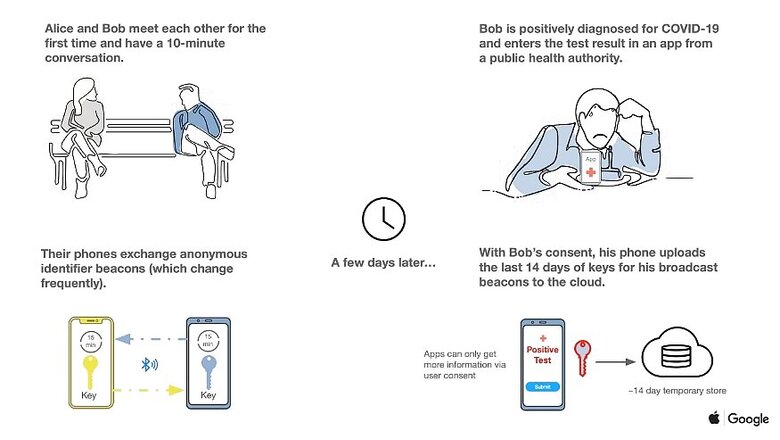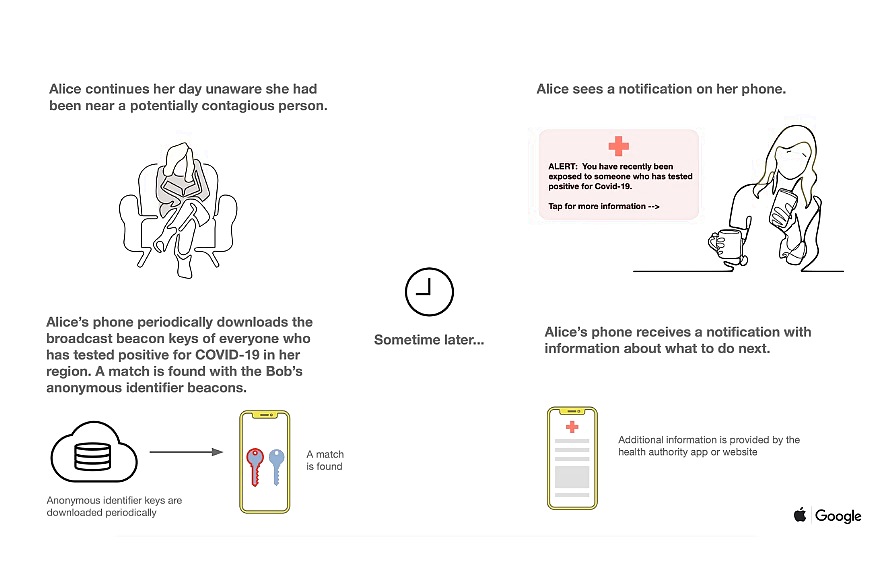
views
When Apple and Google announced last month that they would be working together to develop one of the most critical tech solutions of all time, that could only be classified as an unprecedented announcement. And perhaps timely too, considering the world is fighting the COVID outbreak. Now, that partnership has taken a crucial step forward, with Apple and Google releasing the COVID-19 Exposure Notification API for iPhones and Android phones, something they have been testing for a while now. The iOS 13.5 update now rolling out for the Apple iPhone line-up includes this new API, that for public health agencies (PHAs) and the contact tracing apps they make and deploy. Apple and Google say 22 countries in five continents have requested and received access to the API, and more are expected to join in the coming weeks.
The API will allow PHAs to define what constitutes an exposure event, the number of exposure events an individual has had, factor transmission risk of positive cases into their definition of an exposure event and data that users voluntarily choose to input into the app allows PHAs to contact exposed users.
“Our technology is designed to make these apps work better. Each user gets to decide whether or not to opt-in to Exposure Notifications; the system does not collect or use location from the device; and if a person is diagnosed with COVID-19, it is up to them whether or not to report that in the public health app. User adoption is key to success and we believe that these strong privacy protections are also the best way to encourage use of these apps,” Apple and Google said.
The contract tracing solution that uses the Bluetooth technology in iPhones and Android phones, and will allow government and health agencies around the world to track and notify you in case you have met with or have come in close proximity with someone who is now confirmed to have been affected by the Coronavirus, or COVID-19. Apple and Google have also detailed the privacy aspects and how the data will be collected, time and again. This will work seamlessly across Android phones and the iPhones.
This is How BLE Tracing works
The contact tracing is essentially a Bluetooth Low Energy (BLE) service registered with the Bluetooth SIG with 16-bit Universally Unique Identifier, UUID 0xFD6F, that is designed to enable proximity sensing of Rolling Proximity Identifier between devices for the purpose of computing an exposure event. The two phones, which could be your phone and someone else’s phone in your proximity, will exchange anonymous identifier keys. All the discovered data shall be kept on the device, which is your smartphone. These logs will be uploaded with the user’s consent in case they are confirmed to have been infected by Coronavirus, or COVID. These logs will then be downloaded by your smartphone and matched against the logs your phone has collected via Bluetooth tracing over time. If your logs match any smartphone user who has now been confirmed with COVID, you will see a notification on your phone alerting you about it with steps on what to do next.

You do not require any location data for this to work
Apple and Google say that at no point does the Bluetooth based contract tracing require any location data access. It can work very well without it too. “The Contact Tracing Bluetooth Specification does not require the user’s location; any use of location is completely optional to the schema. In any case, the user must provide their explicit consent in order for their location to be optionally used,” they have said.
All the data stays private
Privacy remains a very important part of this new COVID contact tracing API.
Apple and Google also take pains to emphasise on the point that the list of contacts never leaves your phone, list of people who you may have come in range with never leaves your phone and at no point is the data shared with Apple or Google, in case of a positive test. Only public health authorities will have access to that data—though Apple and Google will have no say in who these authorities then share the data with.
The device location details are not collected at any point. Random Bluetooth identifiers are used to indicate proximity and no identifiable information is shared or logged. Users decide whether they want to report a positive diagnosis and the user identities are not known to other users, Google or Apple. Matching for exposure notifications is only done on device, which means that data isn’t saved or processed on the cloud.
The roadmap for Apple and Google’s Contact Tracing Rollout
Remember, this is not an app in itself. This is an API that public health agencies around the world can integrate into their own apps. For instance, India’s Aarogya Setu, Austria’s Stopp Corona app, Czech’s eRouska, Iceland’s Rakning C-19, Israel’s HaMagen, Singapore’s Trace Together and Norway’s Smittestopp, Australia’s COVIDSafe, CovTracer from Cyprus, Italy’s Immuni and Poland’s ProteGO are all contact tracing app examples that can use the new API—whether they do it or not remains to be seen.
The second stage would be where Apple and Google will work on a Bluetooth-based contact tracing platform which will also be used by apps made by health authorities to track user proximity data—and this will be built into iOS and Android and the option will be available to all users without having to download another app.
This is why Contract Tracing is critical
Contact tracing is critical in curbing the Coronavirus spread around the country and indeed around the world. A person who may be infected with the COVID-19 virus may not show any signs or symptoms for as many as 14 days more but can spread the infection in the meantime through cough, for instance. As and when a confirmed COVID case is taken in for treatment, health authorities scramble to track as many people this infected person may have met in the past few days. “Contact Tracing makes it possible to combat the spread of the COVID-19 virus by alerting participants of possible exposure to someone who they have recently been in contact with, and who has subsequently been positively diagnosed as having the virus,” Apple had said.
Earlier, Apple had released a beta version of Xcode 11.5 and the third beta of iOS 13.5—the Xcode includes tools that developers would need for building iOS apps that incorporate the COVID API, and iOS 13.5 integrates the code needed by apps that will be developed by health authorities around the world. Google has also released similar updates for developers via updates to Google Play Services and the Android Developer Studio.


















Comments
0 comment